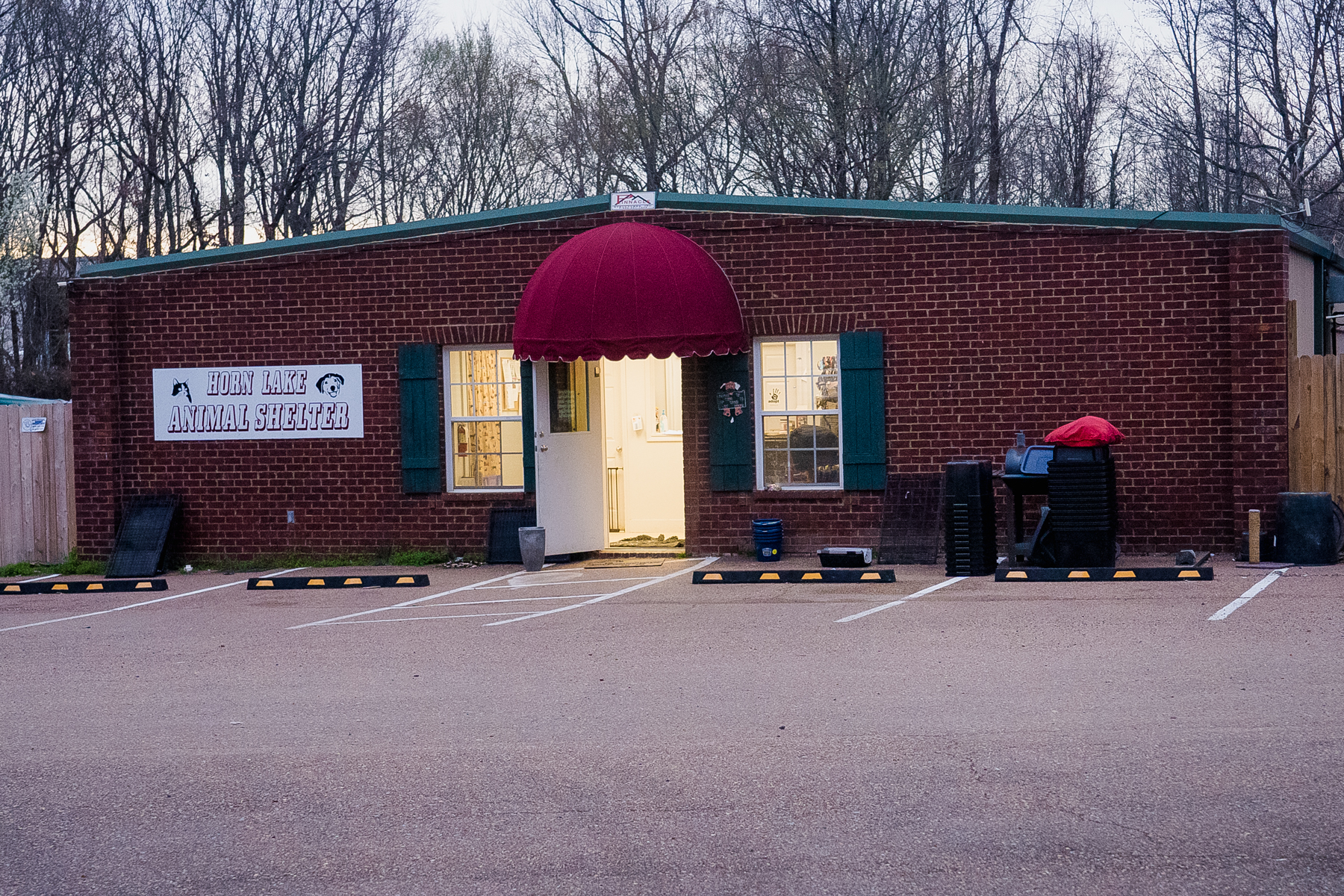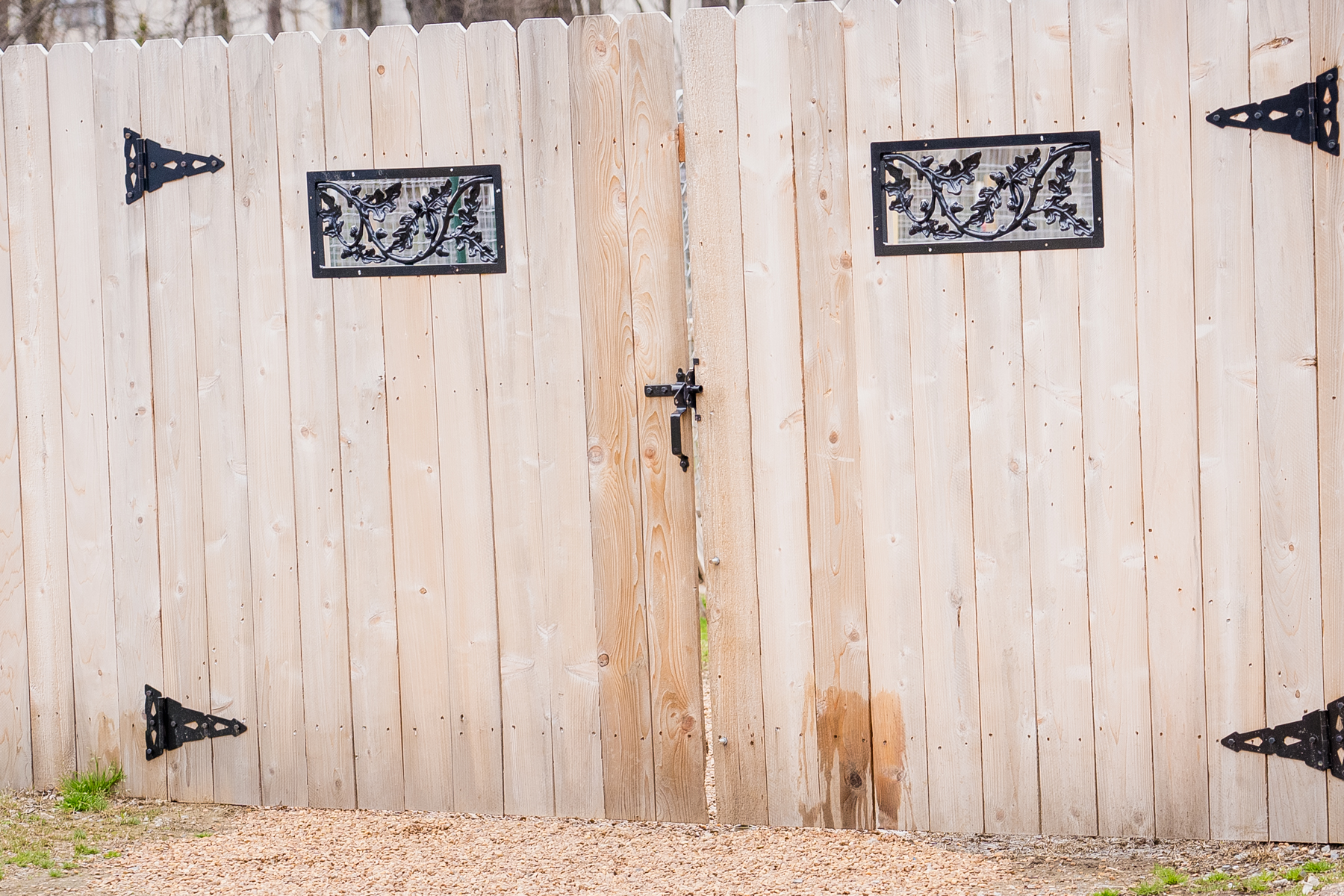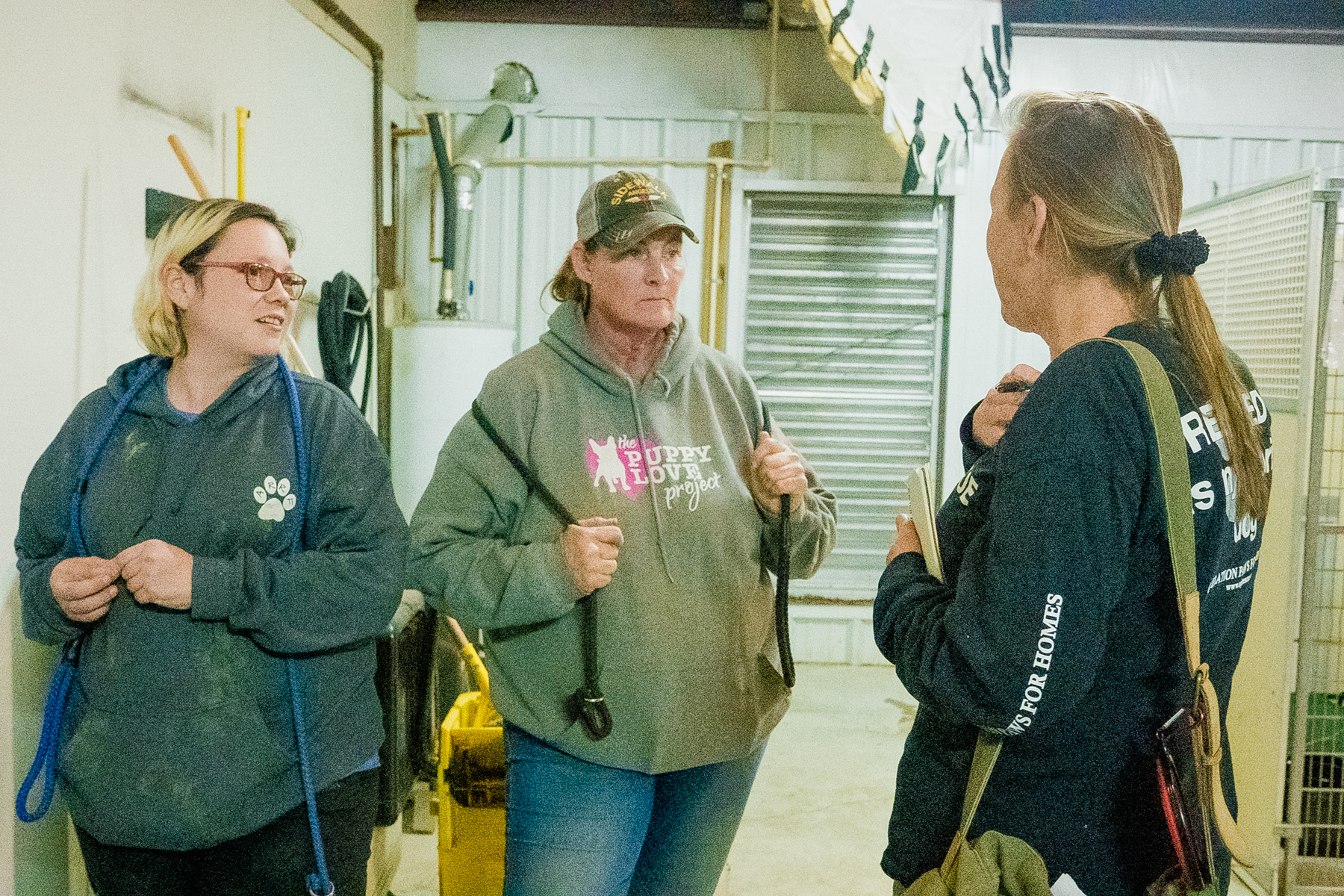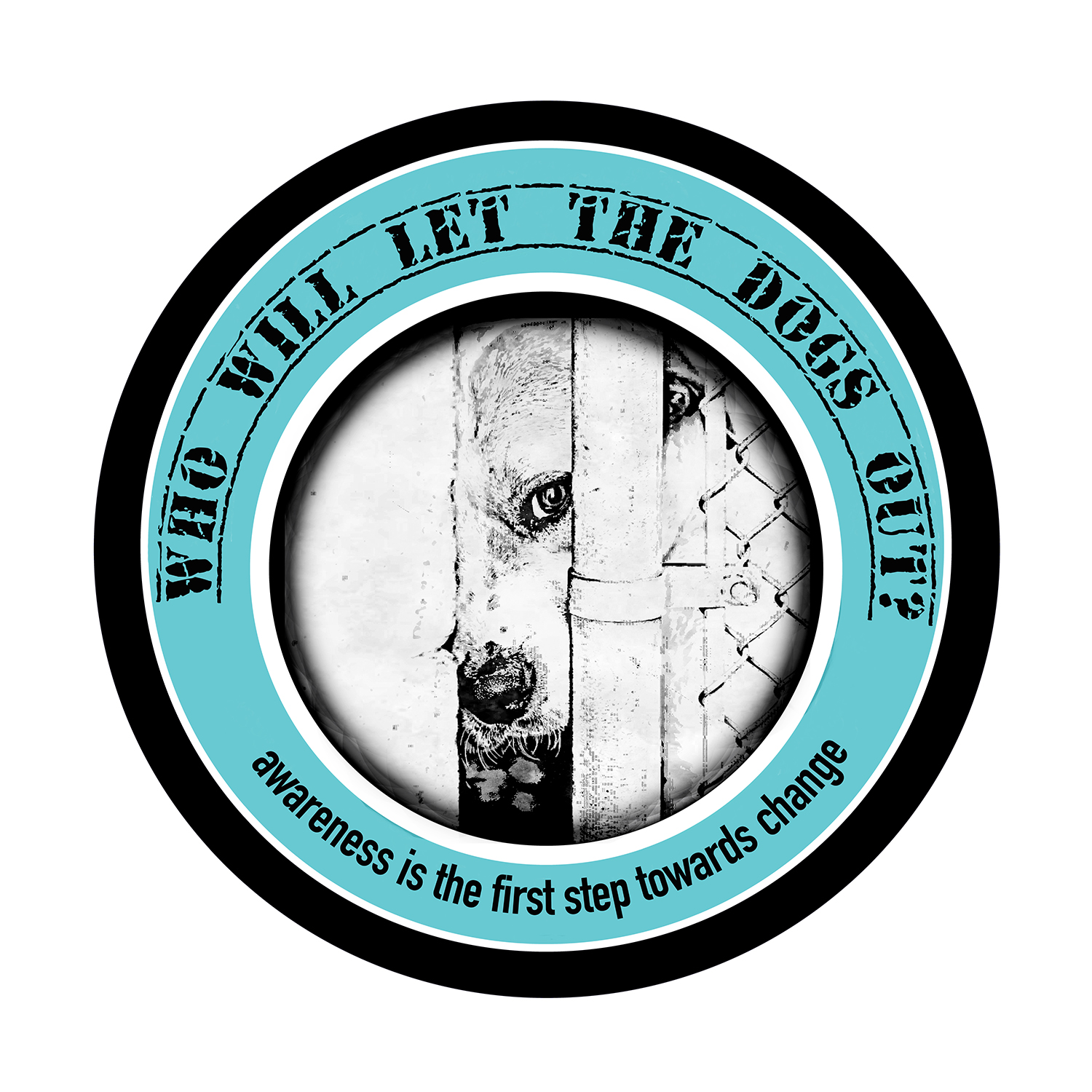After our day with All 4s in Memphis, we were dirty and tired but we still had one more stop—Horn Lake Animal Shelter.
We were headed there because of a woman named Julia who had contacted me shortly before we left on this trip asking if we had time to squeeze in a visit to Horn Lake. We didn’t, but Julia was compelling, so at 4:30pm on Wednesday, we found them just past the dump, sharing space with the public works department.

The first thing we noticed was a new solid tall fence surrounding play yards and large outdoor kennels. The outdoor space was the first thing Horn Lake’s new director changed when she arrived six months ago.

This is where the dogs spend parts of their days, and I would wager this is how the dogs stay sane for what is likely a long stay at Horn Lake.
Julia was in the middle of a rare adoption when we arrived, so we spent a little time with a few of the dogs currently housed in the office while she went through the paperwork for the family who had come back to adopt Gracie, a lucky dog they promised to spoil all the days of her life.
Julia has worked at Horn Lake since last November. “I couldn’t have worked here before,” she told me. She joined the staff after Pat took over as director. She’d volunteered with Pat at ARFF (Arkabutla Rescue, Rehabilitation, and Foster) working with dogs who had no one else.

Julia says no one wanted to take dogs to Horn Lake, it had a reputation as a dark and sad place. She took off all the rescue stickers on her car because when people knew she worked in rescue they would leave dogs tied outside her house rather than take them to the shelter.
Hopefully, Horn Lake has turned a page. The first thing Pat did was build those play yards. She understands that a dog’s emotional and mental health depends on having the opportunity to play and socialize with other dogs. We walked through the yards where muddy dogs raced through the muck and vied for our attention. It has been raining in Mississippi for weeks. They might be muddy, but the dogs sure looked pretty happy.
Next, we went inside to see some of the other dogs. They take turns outside since there are so many dogs at Horn Lake. It was built for 40 but currently is housing closer to 60. Besides the inside kennels, they are housed in crates in every available space, plus an auxiliary space across the road in what used to be the entire shelter but is now the cat space.
We met a group of dogs that Horn Lake picked up after a man died during heart surgery. They were unsocialized and shy; two have deformed legs with no paw. Julia, Pat, and a volunteer, Kelly, are the only ones they will come near. Julia gave them some of the hand-made toys we’d brought along made by an OPH adopter.
Dogs can linger at Horn Lake for well over a year because very few people come here to look at dogs to adopt, maybe a handful a month. Many of the dogs are heartworm positive. The shelter doesn’t have the funds to treat heartworm, people don’t want to adopt a dog that will require expensive treatment, and many rescues won’t pull heartworm positive dogs, so those dogs may sit for years. Julia works every night after she gets home, searching for rescues and long-distance adopters for the few heartworm negative dogs. “Once I get all those adopted, I won’t have any dogs to move,” she tells me.
After spending a day with people in Memphis, only thirty minutes away, who refused a free spay or neuter of their pit bulls because they wanted ‘just one litter’ or because ‘I wouldn’t do that to myself, why would I do it to my dog?’ it was heartbreaking to see kennel after kennel filled with beautiful pit bulls, most dog-friendly and people-loving. Their only crime is being heartworm positive in a part of the country where nearly all adult dogs in shelters are, but having landed in a shelter that will love them and socialize them and rehab them, but doesn’t have enough money to treat their heartworm.
Heartworm treatment can cost as much as $1500 here in the north, but in the south it costs less and most shelters can find a vet willing to discount services and get it done for $500 or less. Still, for a shelter whose budget can barely afford rabies vaccines and spay/neuter, heartworm treatment (or heartworm preventative) is generally not possible.
Dogs like Bones, a senior sweetheart who arrived at Lake Horn quite literally bones but is now a healthy weight and a happy boy. He is nine years old and it’s quite possible he will live out his days here with his best buddy Crystal in the kennel next door. The staff call them the ‘dynamic duo’ and let them out to run in the kennel area when they are closed to the public.
I’m hopeful that with Pat’s leadership and Julia’s advocacy, Horn Lake is headed for better days. So many times we see this—the difference leadership can make. Too many times it is the difference between dogs living and dogs dying, but in this case, it is also the difference between dogs suffering from shelter stress or maintaining their emotional health through smart shelter practices.
It’s also a matter of valuing these dogs that the community has thrown away. Julia told us that one of the changes that Pat made is what they do with dead animals. As part of their Animal Control duties, the Horn Lake staff must pick up animals found dead in their county. The previous leadership at the shelter would simply throw away the bodies in a dumpster. Not Pat, she makes sure that all the animals are cremated because they are not trash. This isn’t a fact that many would even know, but the people at Horn Lake Shelter do because they understand the value of a life.
I’m hopeful for this shelter and grateful for its advocates like Julia and The Friends of Horn Lake. If you’d like to help Horn Lake, follow the shelter on Facebook or send them something from their Amazon Wishlist.
 Until every cage is empty,
Until every cage is empty,
Cara
Please help us by subscribing (button on right side) to and sharing this blog. You can also keep track of us on Facebook and Instagram.
Who Will Let the Dogs Out (we call it Waldo for short) is an initiative of Operation Paws for Homes. If you’d like to contribute to our work, we encourage you to click on the how to help link above and give directly to a shelter. You can also donate to our work via OPH’s donation page by designating Who Will Let the Dogs Out in your comments.
My upcoming book, One Hundred Dogs & Counting: One Woman, Ten Thousand Miles, and a Journey Into the Heart of Shelters and Rescues (Pegasus Books, July 7, 2020) tells the story of not only our foster experience but how Who Will Let the Dogs Out began. It is available for preorder now and a portion of proceeds of every book sold will go to help unwanted animals in the south.



Martha Kennedy
I’m glad that was your last visit. It’s sad but hopeful. <3
Cara Sue Achterberg
Yes that’s exactly what I felt – sad, but hopeful.
Naomi Johnson
It is so sad that “Dogs can linger at Horn Lake for well over a year because very few people come here to look at dogs to adopt, maybe a handful a month.” It is wonderful that they have a caring, dedicated director like Pat and employees like Julia who have made life pleasant for the dogs under
their care, but if the place stays full with dogs living there indefinitely, what happens to the other dogs in the area that are being dumped by uncaring owners? Do they go to a kill-shelter like MARL where they take in “50-60 animals a day with even higher numbers in the summer, often as many as 100.”
Reading MARL’s website, it sounds basically like a pleasant rescue operation; however, reading on we see, “MARL has been and continues to be the leader in shelter adoptions in Central Mississippi. Until the communities in central Mississippi come together to decrease the overpopulation of animals, primarily through strong spay/neuter programs, animals will be put down, because there are no homes available.” However, their “put down rate” seems outrageously high. Of the “ten thousand animals [that] arrived at the shelter [in 2019], 1379 were adopted and 227 were reunited with their owners.” That = 84% euthanasia rate. I think that in 42 years as director Debra definitely should have improved 84%, especially with the (now) budget of $1.1 million, which, I’m wondering includes donations and grants. With an operation that large, not seeking rescue partnership, foster homes, and practicing “hard medicine” seems inhumane if they could decrease their euthanasia rate with someone as an adoption/rescue coordinator.
Anyway, these 2 shelter/rescues are protecting the public by getting unwanted dogs off the streets, but the real problems is that the dogs are unwanted, unneutered, and unspayed. That is the real problem that needs to be solved. We must educate the public, and that is what Cara is trying so hard to do. Thank you, Cara. You are my hero!!!
Cara Sue Achterberg
Thanks Naomi – you highlighted several of the true problems here – the huge number of dogs and the difference leadership makes in terms of the numbers. Absolutely 84% is not acceptable at MARL and rescue/foster could change that, but until MARL has leadership like Horn Lake, that won’t happen. Imagine what Pat and Julia could do with a 1.1 million dollar budget! I don’t know what their budget is, but I doubt it’s even one quarter of that.